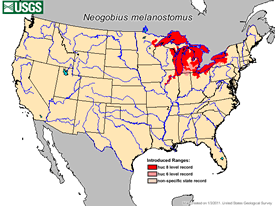Home | Detectives | Suspects | Background Check | Kids' Headquarters | Top Desk Administrator | Case Files
Neogobius melanstomus
THE CRIMES: Displaces native fish. Feeds on fish eggs and young fish. Spawns multiple times a year.
DESCRIPTION: Bottom-dwelling fish slightly resembling a large tadpole with a big head, narrower body, frog-like raised eyes and thick “lips.” Body is mostly slate gray and mottled with black to brown spots. It grows from 15 – 30.5 cm (6-12 in). A fused pelvic fin forms a suction disk.
The Interrogation
Where are you from?
I came from the Black and Caspian Seas.
How did you get here?
Me and my goby buddies hitched a ride on a transoceanic vessel to the
St. Clair River, the channel between Lake Huron and Lake St. Clair around 1990. The St. Clair River
was fine for a few years but it got a little crowded in 1993 since my goby relatives populate so
quickly. We have spread to all of the Great Lakes since then. Now, after menacing the Great Lakes,
we are heading for the Mississippi River.
What’s your problem?
Can I help it if I’m so competitive and aggressive that I push out other
bottom-dwelling fish such as mottled sculpin, log perch, and darters? They lose out on their preferred
habitat and spawning areas. Being a “lowlife,” I feed on bottom-dwelling invertebrates,
fish eggs, and other small fish in rocky, cobble surroundings. Like other animals, I defend my spawning
area and don’t allow other native fish near them.
Can I help it that I also have a well-developed sensory system that allows me to eat
in the dark, which gives me the edge over the native fish?
Cut me a little slack! I do eat those menacing zebra mussels. I can devour more
than 75 zebra mussels a day. Fortunately for me, zebra mussels reproduce so fast that I’ll always
be able to find those tasty little mollusks. The problem for you humans is that although there are plenty
of us around, there just aren’t enough of us to eat all those zebra mussels.
How can we control you?
Ballast dumping regulations in North America are one way of preventing us from spreading
to other waterways. It’s also important to educate anglers and others to avoid spreading us accidentally.
We should not be used as bait! Bait buckets should be dumped only in areas where they were filled, and we should
not be brought home to live in your aquariums.
Reward:
The honor of protecting our water resources— A healthier environment
and more opportunities to enjoy our natural areas.
